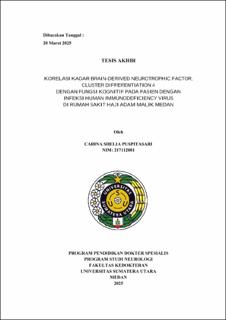| dc.description.abstract | Background: HIV infection leading to CD4 depletion and neurocognitive impairment in 30-50% of cases, known as HIV-Associated Neurocognitive Disorder (HAND). The mechanisms underlying HAND remain unclear, but reduced Brain-Derived Neurotrophic Factor (BDNF), essential for neuroplasticity, psychomotor function, memory, and learning, may play a role. However, the relationship between BDNF, CD4 levels, and cognitive function in HIV remains poorly understood.
Objective: To determine the correlation between BDNF and CD4 levels with cognitive function in patients with HIV.
Method: This cross-sectional study included 58 patients from Pusyansus who met the inclusion and exclusion criteria from July 2024 to January 2025. Blood samples were collected to assess BDNF and CD4 levels. MoCA-Ina was used to see the cognitive globally and then continue with Stroop Test was used to evaluate cognitive function, measured in seconds. The Spearman correlation test was applied to determine the relationship between BDNF, CD4, and cognitive function in HIV-positive subjects. Kruskal wallis test was used to see the differences BDNF levels in HAND groups.
Result: The majority of subjects were male (79.3%), with a mean age of 38.77 ± 9.28 years, The mean BDNF level was 1.08 ± 0.59 ng/mL, CD4 level was 512.60 ± 331.08 cells/mm³, the mean and MoCA-Ina score was 23, and the mean Stroop Test score was 68.75 ± 24.60 seconds. A significant negative correlation was found between BDNF level and cognitive function using stroop (r = -0.288, p = 0.028); and MoCA-Ina (r 0.784 ; p 0.01). No significant correlation was found between CD4 level and cognitive function (p = 0.036). From the total subject, there were normal cognitive (58.6%), ANI 19%, MND 8.6%, and HAD 13.8%. There is a difference between HAND group (p 0.004).
Conclusion: A significant correlation was observed between BDNF and cognitive function in HIV-positive subjects, indicating the potential role of BDNF in cognitive impairment associated with HIV.
Keywords: BDNF, CD4 HIV, HAND, cognitive | en_US |


